
Magenta is a purplish-red color. On color wheels of the RGB (additive) and CMY (subtractive) color models, it is located precisely midway between violet and red. It is one of the four colors of ink used in color printing by an inkjet printer, along with yellow, cyan, and black to make all the other colors. The tone of magenta used in printing, printer's magenta, is redder than the magenta of the RGB (additive) model, the former being closer to rose.
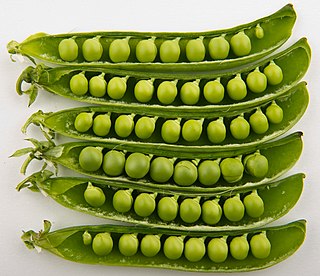
Pea is a pulse, vegetable or fodder crop, but the word often refers to the seed or sometimes the pod of this flowering plant species, formerly 'Pisum sativum', it has been proposed to rename the species as Lathyrus oleraceus. Each pod contains several seeds (peas), which can have green or yellow cotyledons when mature. Botanically, pea pods are fruit, since they contain seeds and develop from the ovary of a (pea) flower. The name is also used to describe other edible seeds from the Fabaceae such as the pigeon pea, the cowpea, the seeds from several species of Lathyrus and is used as a compound form for example Sturt's desert pea.

Papermaking is the manufacture of paper and cardboard, which are used widely for printing, writing, and packaging, among many other purposes. Today almost all paper is made using industrial machinery, while handmade paper survives as a specialized craft and a medium for artistic expression.

Rooibos, or Aspalathus linearis, is a broom-like member of the plant family Fabaceae that grows in South Africa's fynbos biome.

The lentil is an edible legume. It is an annual plant known for its lens-shaped seeds. It is about 40 cm (16 in) tall, and the seeds grow in pods, usually with two seeds in each.

A rubber stamp is an image or pattern that has been carved, molded, laser engraved, or vulcanized onto a sheet of rubber. Rubber stamping, also called stamping, is a craft in which some type of ink made of dye or pigment is applied to a rubber stamp, and used to make decorative images on some media, such as paper or fabric.
Rice paper is a product constructed of paper-like materials made from different plants. These include:

The mung bean, alternatively known as green gram, mungo bean or mongo bean, is a plant species in the legume family. The mung bean is mainly cultivated in East, Southeast and South Asia. It is used as an ingredient in both savoury and sweet dishes.

Chromoplasts are plastids, heterogeneous organelles responsible for pigment synthesis and storage in specific photosynthetic eukaryotes. It is thought that like all other plastids including chloroplasts and leucoplasts they are descended from symbiotic prokaryotes.

A paper bag is a bag made of paper, usually kraft paper. Paper bags can be made either with virgin or recycled fibres to meet customers' demands. Paper bags are commonly used as shopping carrier bags and for packaging of some consumer goods. They carry a wide range of products from groceries, glass bottles, clothing, books, toiletries, electronics and various other goods and can also function as means of transport in day-to-day activities.
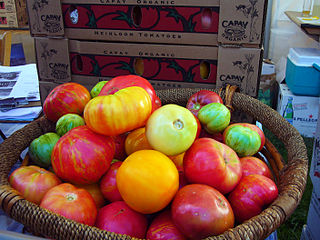
An heirloom tomato is an open-pollinated, non-hybrid heirloom cultivar of tomato. They are classified as family heirlooms, commercial heirlooms, mystery heirlooms, or created heirlooms. They usually have a shorter shelf life and are less disease resistant than hybrids. They are grown for various reasons: for food, historical interest, access to wider varieties, and by people who wish to save seeds from year to year, as well as for their taste.
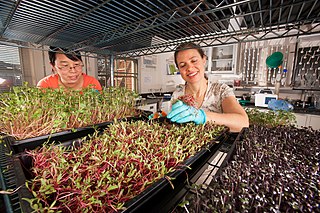
Microgreens are vegetable greens harvested just after the cotyledon leaves have developed with one set of true leaves. They are used as a visual, flavor and texture enhancement. Microgreens are used to add sweetness and spiciness to foods. Microgreens are smaller than "baby greens" because they are harvested soon after sprouting, rather than after the plant has matured to produce multiple leaves.
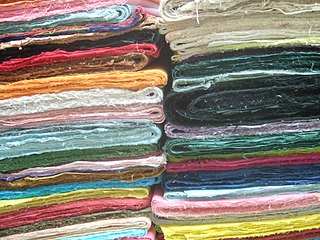
Korean paper or hanji is the name of traditional handmade paper from Korea. Hanji is made from the inner bark of Broussonetia papyrifera, known colloquially as paper mulberry, a tree native to Korea that grows well on its rocky mountainsides, known in Korean as dak. The formation aid crucial to making hanji is the mucilage that oozes from the roots of Hibiscus manihot. This substance helps suspend the individual fibers in water.

The tradition of egg decoration in Slavic cultures originated in pagan times, and was transformed by the process of religious syncretism into the Christian Easter egg. Over time, many new techniques were added. Some versions of these decorated eggs have retained their pagan symbolism, while others have added Christian symbols and motifs.

Fique is a natural fibre that grows in the leaves of plants in the genus Furcraea. Common names include fique, cabuya, pita, penca, penco, maguey, cabui, chuchao and coquiza.

Paper is a thin sheet material produced by mechanically or chemically processing cellulose fibres derived from wood, rags, grasses, or other vegetable sources in water, draining the water through a fine mesh leaving the fibre evenly distributed on the surface, followed by pressing and drying. Although paper was originally made in single sheets by hand, almost all is now made on large machines—some making reels 10 metres wide, running at 2,000 metres per minute and up to 600,000 tonnes a year. It is a versatile material with many uses, including printing, painting, graphics, signage, design, packaging, decorating, writing, and cleaning. It may also be used as filter paper, wallpaper, book endpaper, conservation paper, laminated worktops, toilet tissue, currency, and security paper, or in a number of industrial and construction processes.

The Museum of Papermaking in Duszniki-Zdrój is a historical museum located in the spa town of Duszniki-Zdrój in the Lower Silesian Voivodeship, southwestern Poland. It was founded in 1968 in an old 16th-century paper mill on the Bystrzyca Dusznicka river.

Postage stamp paper is the foundation or substrate of the postage stamp to which the ink for the stamp's design is applied to one side and the adhesive is applied to the other. The paper is not only the foundation of the stamp but it has also been incorporated into the stamp's design, has provided security against fraud and has aided in the automation of the postal delivery system.
Ingres paper is a type of drawing paper. It is a laid finish paper of light to medium weight, and it is not as strong or as durable as Bristol paper. Laid finish refers to the imprint of regular screen pattern of a papermaker's mould. Ingres is not necessarily a handmade paper, but is produced to replicate the properties of laid paper. Ingres is often used for charcoal and pastel drawing. It is also used as an endpaper in books.
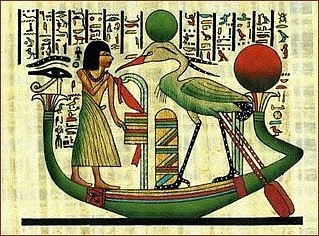
Watercolor paper is paper or substrate onto which an artist applies watercolor paints, pigments, or dyes. Many types of watercolour papers that are manufactured for the use of watercolors are currently available. Watercolor paper can be made of wood pulp exclusively, or mixed with cotton fibers. Pure cotton watercolor paper is also used by artists, though it typically costs more than pulp-based paper. It is also available as an acid-free medium to help its preservation.
















